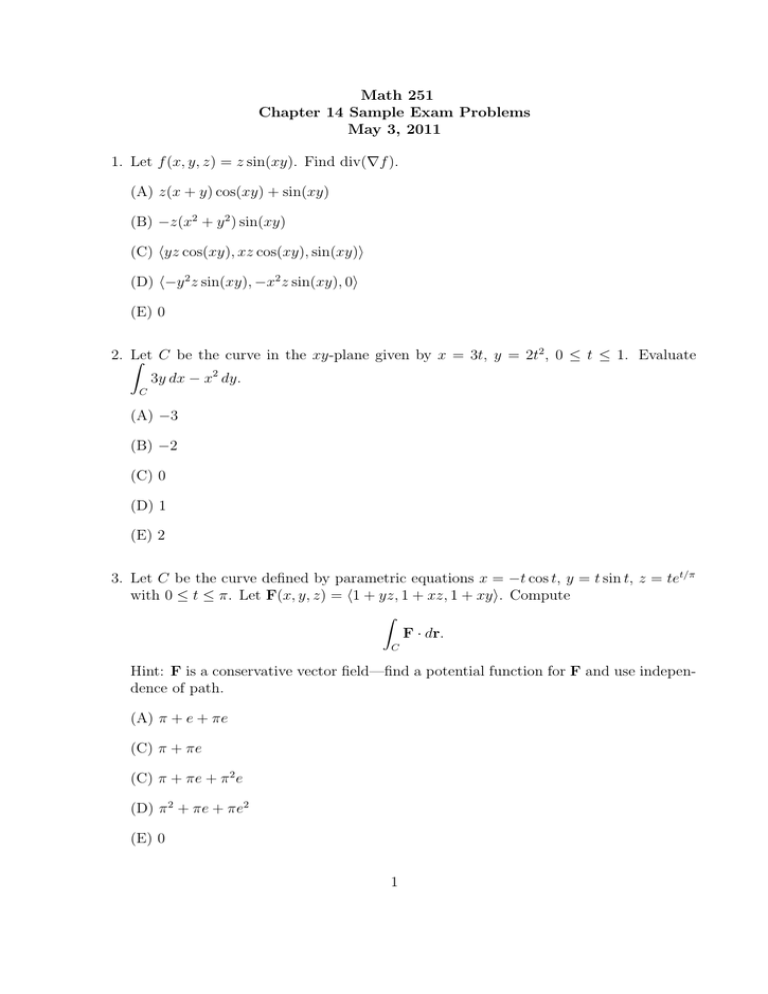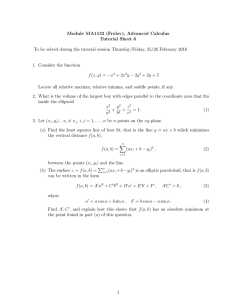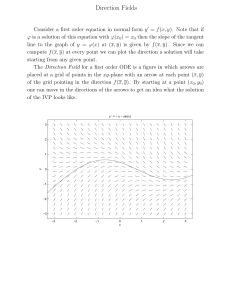Math 251 Chapter 14 Sample Exam Problems May 3, 2011
advertisement

Math 251 Chapter 14 Sample Exam Problems May 3, 2011 1. Let f (x, y, z) = z sin(xy). Find div(∇f ). (A) z(x + y) cos(xy) + sin(xy) (B) −z(x2 + y 2 ) sin(xy) (C) hyz cos(xy), xz cos(xy), sin(xy)i (D) h−y 2 z sin(xy), −x2 z sin(xy), 0i (E) 0 2. Z Let C be the curve in the xy-plane given by x = 3t, y = 2t2 , 0 ≤ t ≤ 1. Evaluate 3y dx − x2 dy. C (A) −3 (B) −2 (C) 0 (D) 1 (E) 2 3. Let C be the curve defined by parametric equations x = −t cos t, y = t sin t, z = tet/π with 0 ≤ t ≤ π. Let F(x, y, z) = h1 + yz, 1 + xz, 1 + xyi. Compute Z F · dr. C Hint: F is a conservative vector field—find a potential function for F and use independence of path. (A) π + e + πe (C) π + πe (C) π + πe + π 2 e (D) π 2 + πe + πe2 (E) 0 1 4. Let S be the portion of the paraboloid z = 1 − x2 − y 2 above the xy-plane, and let n be an upward unit normal Z Z vector for S. Let F(x, y, z) = hx, y, 2zi. What is the value F · n dS? of the surface integral S (A) 2π (B) −2π (C) π (D) −π (E) 0 5. Evaluate the following line integrals. Z (a) Evaluate (x2 + y 2 + z 2 ) ds, where C is the curve in 3-space given by x = 4 cos t, C y = 4 sin t, z = 3t, 0 ≤ t ≤ 2π. Z 2 (b) Evaluate 3yex + 2ex dx + C 3 2 x 2 + sin y dy, where C is the triangle in the xy- plane with vertices (0, 0), (2, 0), (2, 4), oriented counter-clockwise. (Hint: Use Green’s Theorem.) 6. Let F = 2yi − 2xj be a vector field in the xy-plane. Let C be the unit circle oriented counterclockwise, and let R be the closed unit disk. I (a) According to Green’s Theorem, F · dr is equal to what double integral? C I F · dr directly. (b) Evaluate C (c) Evaluate the double integral you provided in part (a) directly. ZZ 7. Use Stokes’ Theorem to calculate the surface integral (curl F) · n dS, where S is S the part of the paraboloid z = 9 − x2 − y 2 above the xy-plane, n is the outward unit normal, and F = hz + y, z − x, 2zi. 8. Let S be the graph of f (x, y) = x2 + y 2 above the unit disk R in the xy-plane. The boundary of S is the circle C that is a translate of the usual unit circle in the xy-plane, 1 unit directly upward. Let F = yi − xj + yzk. Use Stokes’ Theorem to evaluate I F · dr, C where C is oriented counter-clockwise. 2







